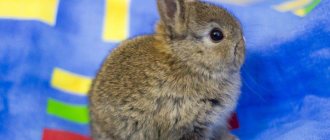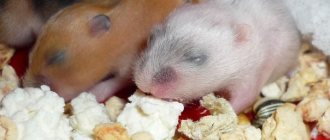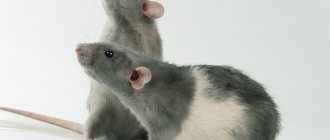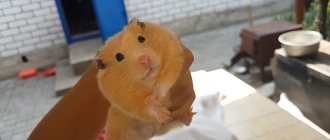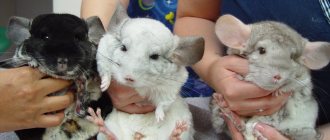Expert opinion
Dobryshev Sergey Anatolievich
Professional rabbit breeder and hare breeder with 30 years of experience
Proper care of rabbits is vital to the business called rabbit farming. This guarantees the production of a healthy, full-fledged population of animals capable of producing tasty dietary meat and beautiful fluffy fur.
The rules for caring for rabbits are not particularly complicated, but they require compliance with the necessary requirements and vigilant attention.
Accommodation features: rabbit house
If you decide to get rabbits and create a mini-farm in the village, then at the first stage you need to take care of their place of residence. A ready-made room for a rabbitry is created or used. The animals will be housed more compactly in 2-tier cages. Keeping rabbits indoors is more convenient and rational. Drafts and dampness, prolonged exposure to the sun should be avoided, but ventilation should be provided.
Outdoor home cage option
For a pet, the cage is placed away from heating appliances. If you raise a rabbit in a hot room, the rabbit will experience constant thirst and its health will worsen. It is not recommended to keep him in a cage all the time. In order for the indoor pet to feel good, it is allowed to run around the apartment.
Longer stay for pets - their cage
Keeping an animal’s “house” clean is an important condition for its health. Dirt and urine cause respiratory and eye diseases, so the tray is cleaned three times a week. Once a week, wash thoroughly using disinfectants.
Portable cage option
Feeders, drinking bowls, and hay mangers should be placed in the cage. They need to be well secured so that the animals cannot spill water or contaminate the food. They need to be washed as often as possible.
Animals love to eat indoor flowers. It is necessary to remove poisonous plants from the apartment, install the rest on cabinets or hang them in flower pots.
Is it possible to keep rodents together with chickens? Their cohabitation is possible only if there are no other options. Although they are completely different species, they have common diseases. In addition, the “eared” ones feel uncomfortable in the company of noisy and hectic hens. Therefore, keeping chickens and rabbits together is not recommended.
Arrangement of cells
You should think about where to live before purchasing your first pair of rabbits. Usually, for this purpose, ready-made cages and enclosures are purchased or created with your own hands from scrap materials.
It should be noted that these animals are known for rapid reproduction, so the cages must be spacious enough. To save space, you can purchase or build two- or three-story homes for future pets.
With a large population, several cages can be installed close to each other.
The cage must have a roof on top that protects the animals from precipitation, and on one side the farmer must have access if necessary to get the rabbit out for inspection or for another purpose. The cages should not be installed directly on the ground, so the design includes legs at the bottom.
From the outside, the doors close with a latch to block the escape route for frisky rodents. Each compartment must have the ability to install feeders and drinkers. To facilitate cleaning, there should be a retractable tray at the bottom of the structure to collect animal excrement.
In the warm season, housing for rabbits is installed directly in the courtyard, choosing an area protected from drafts and direct sunlight.
In winter, if possible, they should be moved to a barn or basement. If this is not possible, then insulation must be carried out by covering the cells with appropriate material.
If space allows, you can build enclosures for your pets. This allows them to take walks, fulfilling the need for movement. Rabbits can nibble not grass stored for future use, but grass growing directly on the ground.
Enclosures have a simpler design than cages, so building them with your own hands will not be difficult and will not cost much. Another advantage is that rabbits living in enclosures in spartan conditions acquire stronger immunity, get sick less often and reproduce more intensively.
Since the animals can jump very high, it is necessary to make a restriction on top, possibly from the same material as the walls. This will also protect against small predators getting inside.
Farmers notice that rabbits placed in an enclosure seem to improve their mood. They become more playful and cheerful than their counterparts living in tighter cages. The house leaning against the enclosure serves as a nest where females bring offspring and nurse them.
Another option for breeding animals is to keep them in a specially equipped pit. This is more economically beneficial. Since their ancestors, wild rabbits, live in burrows they dug themselves, domestic rodents, obeying instinct, will quickly get used to this way of life.
This method is more suitable for raising meat breeds, since the skins can be damaged during fights, which are difficult to control. In addition, incest between related individuals is possible, which leads to deterioration of health and degeneracy.
This method cannot be used in places with a large amount of sand, which can begin to crumble and lead to the death of the inhabitants of the pit. It is unacceptable to breed rabbits in a pit built in an area where regular flooding occurs.
Feeding rabbits: diet
Caring for a rabbit involves a balanced and thoughtful diet. It is necessary to keep track of what and in what quantities the animals eat. There is a special feed to which they need to be accustomed. Due to the hard granules, the rabbit's teeth are well ground down, the growth of which never stops.
In summer, the best diet for rabbits is fresh grass.
In winter, hay is added to the diet. The feeder should contain solid food: carrots or other root vegetables, hard branches of fruit trees. Prepare mash with boiled vegetables or potatoes with the addition of bran. Small amounts of salt, bone meal and chalk should be present in the diet. Feeding occurs twice a day, with a 12-hour break between them.
When breeding rabbits, proper feeding is very important.
An important condition is to constantly add water to the drinking bowls. Without water, feed is not fully digested. If the food is dry, then the “eared” one needs 0.5 liters per day. water. In summer there is no such need for water, since the feed is succulent.
Possible health problems: the most common diseases of rabbits
Vaccinations are given to animals for preventive purposes.
Rabbits are strong animals. However, maintaining their health must be approached responsibly.
Preventive measures are important:
- cleaning cages, feeders, drinking bowls;
- ventilation of houses and nests;
- preventive examination before mating;
- Vaccination.
What diseases are rabbits susceptible to:
- Intestinal diseases due to poor quality, stale food.
- Plantar dermatitis. It is more common in large, heavy individuals.
- Coccidiosis is a viral disease that leads to the destruction of liver and intestinal cells.
- Myxomatosis is a dangerous viral inflammatory disease.
- Viral hemorrhagic disease of rabbits. Treated with vaccination. When the disease occurs, the pet dies.
- Stomatitis.
Basic care requirements
A rabbit is a mobile animal that needs activity. For walks, he is wearing a harness (collar with leash). In order not to scare the animal, the harness must be put on carefully and slowly. The harness is not tightened, but fastened, otherwise the rabbit may strangle itself out of fear.
Before purchasing a pet, carefully study the question of how to properly care for rabbits. There are many important care techniques, without which the animal will feel uncomfortable.
Nail trimming
When kept in grazing conditions, the claws grind down on their own, but in apartment conditions this is impossible. The cutting technique is simple; the claws can be cut with clippers. The procedure is carried out regularly: the claws are cut once a month. Trimmed claws are carefully filed. Trim them carefully as they contain capillaries.
Vaccination
Furry pets are susceptible to various diseases, so vaccination is very important. Vaccines are administered at one and a half months of life, when the baby rabbit weighs 0.5 kg. It is necessary to vaccinate rabbits during this period.
Fur care
The animal's fur needs daily care (even during molting) so that tangles do not form in the fur. Hair mats quickly, so use a comb or slicker for cats or dogs. Wool often gets into the animal's stomach, clogging the intestines. This is the most dangerous disease that can be prevented by caring for your fur.
Bathing a rabbit
Is it possible to bathe rabbits? A furry pet does not need this procedure when it is at home. Yes, and washing it is not so easy. If the rabbit is very dirty, then bathing is necessary. The process of taming to this procedure is impossible. If the contamination is partial, then wipe the dirty area with a damp cloth.
Grinding down teeth
An animal's teeth grow throughout its life, and caring for a rabbit at home involves regularly grinding them down. Teeth are ground down using:
- Special feed;
- Hard vegetables;
- Branches of fruit trees;
- Special sticks with vitamins and cereals, toys.
Castration
Castrating a rabbit at home involves removing the male reproductive organs. Sterilization is a necessary procedure that helps:
- Increase their growth by 20% without additional costs for feed;
- Keep males in one cage;
- Indoor rabbits stop breeding;
- Increase their lifespan.
Castration of rabbits promotes their calmer behavior: they are not aggressive and do not bite. They are neutered between the ages of 4 months and 2 years.
Difference from sterilization
Castration of rabbits is an operation as a result of which they are deprived of the opportunity to have offspring. Spaying rabbits is sometimes called neutering, but there is a significant difference between the two. Since sterilization does not involve resection of any organs, the ability to reproduce disappears, but the natural desire to mate remains.
Sterilization of rabbits involves bandaging. In this case, the reproductive organs are ligated - in females the fallopian tubes, and in males the seminal ducts. The behavior of animals during certain periods remains aggressive and unpleasant.
Unlike sterilization, castration of rabbits immediately solves all problems that have arisen. The result of castration of rabbits is the absence of pregnancy. Their behavior also changes - they stop falling into a state of hunting, that is, the natural desire to mate disappears. Even during the mating season, their behavior continues to remain calm.
The essence of castration of rabbits is to cut off the ovaries in females and the testicles in males. You can have your rabbit castrated by professionals or by yourself.
Taming the litter tray, litter trays
The big-eared dog quickly gets used to the special toilet installed in the cage. When he starts going to the litter box in a crate regularly, you can try toilet training him in one place in the house.
Rabbit tray
You can recognize why an indoor animal refuses to go to a place adapted for it for a number of reasons:
- The tray is not large enough or is inconvenient;
- Filler that is unpleasant for animals;
- Inappropriate location chosen for the toilet.
Teaching a rabbit to “visit one place” is quite possible. An adult castrated rabbit is easier to tame than a three-month-old baby rabbit. Gradually he will recognize his litter box.
Rabbits feel more comfortable with artificial filling
Artificial fillers create more comfortable conditions for animals and make them easier to care for, which eliminates the question of how to accustom a rabbit to a litter tray. Fillers are:
- Wood from compressed granules;
- Mineral;
- Silica gel
- Japanese.
The highest quality, safest and most expensive are silica gel fillers, which are changed once every 30 days. The choice is up to the owner.
What to feed an adult hare
A hare needs a varied diet. His diet must include:
- Vegetables and fruits, berries (the hare will happily eat apples, pears, zucchini, pumpkin, blackberries, strawberries and even pineapple)
- Root vegetables (beets, carrots, turnips)
- Fresh greens and branches. Suitable branches and leaves of plants such as maple, birch, juniper, apple trees, pears, rose bushes, willow, oak and spruce branches.
In summer it is advisable to give succulent, green branches. In winter you can give branches without foliage. Important! Branches toxic to hares: cherry, black cherry, apricot, plum, peach. You can give hay. The best one is one that contains young grasses and alfalfa.
Products harmful to the hare: bread and other flour products, various nuts (walnuts, peanuts), chocolate, rhubarb, meat. It is not advisable to give grain products and potatoes.
Hand Taming
To understand how to accustom a rabbit to your hands, you need to watch it. At first he will be shy, so you need to talk to him so that he gets used to the environment and the new owner.
Rabbits at home
Since this is a burrowing animal, being raised above the ground is a shock for it. Do not lift the animal by the ears. This is very painful for him and can damage the ear membranes and muscles. This must be done very carefully so as not to cause fear:
- Stroke the animal's fur - from head to tail
- Take it under the body, supporting it from below
- Do not lift it high, keep it at the same level with you.
If you behave correctly and carefully handle the animal, then the question of how to tame a rabbit will disappear by itself.
Rabbits are animals with a developed nervous system. Loud sounds, noise, flashes of light, and unexpected changes in daily routine become stressful for him. Try to protect him from this and do not touch him when he eats, washes or sleeps.
Special toys have been created for those with big ears. Small rubber balls, soft toys, and old books will do. They develop the rabbits physically, and they don't damage household items as much. How to stop a rabbit from chewing wires: give him a toy.
Why does a rabbit bite?
The animal's aggression manifests itself in the form of grumbling, throwing and biting. They bite most often out of fear. A female with cubs may also bite to protect her offspring. Food and territory are also a matter of protection, so the reasons may vary. In order to wean a rabbit from biting you need to:
- Try to change his diet;
- Castrate;
- Treat him with care and precision to rid him of fear.
It is important for a pet to know that he and his offspring are safe, then he will stop behaving aggressively. A physiological factor such as sleep is also important.
Sometimes it seems that animals do not sleep at all. But most often they do not sleep at night, and during the day they look awake, but in fact their eyes are slightly closed and they almost do not react to sounds: this is how rabbits sleep.
Is it possible to grab it by the withers?
If you look at the photo below, you will see that it is also not recommended to take an animal by a fold of skin on the neck or back. This is not as dangerous as in the case of the ears, but there are other, safer ways.
The fact that this method is more comfortable for the animal is evidenced by the fact that, as a rule, in this situation it does not break out or scratch. Most often, the crawl simply hangs down, while its neck and head are pulled back somewhat.If you use this method of lifting, then you must support the crawl’s body in the sacrum area with your second hand.
By the way, it is by the withers that the rabbits are carried by their parents. Some rabbit breeders advise holding animals with both hands at the same time: one in the neck area, the other in the back area. This way it will be in a horizontal position, and the body weight will be evenly distributed.
Lifespan and sex determination
On average, furry rodents live from 5 to 10 years. It all depends on the care and maintenance, on the attitude towards the animal. Large females become sexually mature at 5-8 months, and decorative ones at 4-6 months. The reproductive instinct is pronounced, pregnancy lasts about a month. In the litter of large breeds there is a maximum of 12 cubs, in decorative breeds - up to 5 individuals.
Giant White Rabbit Family
After giving birth, small and helpless rabbits are born. Newborn babies are born naked, their eyes open after 2 weeks. They begin to eat independently 15-17 days after birth. In the first days of life and during the growth period of the rabbits, the female rabbit needs to be fed well, and try to make her diet more varied. Baby rabbits need to be cared for with care and caution. Babies must be with their mother for up to 3 months, after which they are prepared for sale. So the female takes care of the rabbits for up to 3 months.
The sex of baby rabbits can be determined closer to 3 months of their life.
Until the age of three months, no one will answer the question of how to find out the gender of a rabbit, since during this period it is impossible to find out the gender. In older animals, males can be distinguished from females only by their reproductive organs. The sex of a rabbit is determined by carefully examining the reproductive systems of the rabbit and the female rabbit. This is the only method by which one can tell whether a boy or a girl has been born.
How to determine the age of a rabbit?
It is impossible to determine exactly how many years animals live by external signs. But there are a number of techniques that allow you to do this:
- Palpation of the ribs, which can be easily felt. Up to 6 months, the ribs are soft;
- Teeth enamel color. The yellower the teeth, the older the rabbit;
- In an adult “eared” eyelids sag, swell, and become uneven;
- The length of the claws, even if they are cut, these places are clearly visible. In older individuals they bend.
Experienced rabbit breeders can determine the approximate age of an animal based on these characteristics. It is impossible to do this by size, since the size depends on the breed and a number of other factors.
The most common types of hares
The snowshoe hare acquires a spotless white coat in winter, which makes it indistinguishable in the snow. In summer, the coat takes on a grayish color. Weighs on average 3-4 kg. According to the observations of zoo workers and rehabilitation centers, it has a calmer, melancholy disposition than the brown hare and is easier to tame.
Brown hare
the largest of all hares, can weigh 6-7 kg. In summer it wears brown fur, in winter it becomes lighter, but it cannot boast of such impeccable white fur as the hare. The character is more explosive and choleric, but tolerates stress more easily than the white hare.
Tolai hare
It looks like a hare, but is small in size (weighs 2-3 kg). It is distinguished by huge ears, larger than those of a hare.
Dwarf hare
This is exactly what they often offer to buy at a pet store. In fact, there are no dwarf hares, but this name is used by one of the oldest breeds of dwarf rabbits, which are also called Polish rabbits. The Red Book Patagonian pig, a rodent that has nothing to do with the hare family, but is similar in appearance, also claims the title of dwarf hare.
Slaughter
The slaughter process is the most unpleasant action, but if you keep rabbits for meat, you need to study the intricacies of the process. Experienced rabbit breeders advise starting slaughter no earlier than the animal is 4 months old and never slaughter pregnant or lactating rabbits.
Procedure:
- Before the scheduled day, place the animal separately and do not feed it so that the stomach and intestines are cleansed.
- Remove the rabbit carefully, holding it by the hind legs.
- Using a stick wrapped in rags, deliver a precise blow to the back of the head.
- Place the carcass on spacers, pierce the artery through the mouth, remove the eyes and wait until the blood drains completely.
Reviews
When I started raising rabbits, I wanted to increase the number of heads, I wanted to cut costs, I didn’t buy new cages, I put more rabbits in cages. It turned out that some animals grew small, others grew too fat. The difference in weight reached 1.5 kg. So I decided to reduce the number of heads to 2-3 per cage. My profit increased by 15%. All steps taken must be carefully thought out; it is better to consult a specialist.
Igor
Mistakes of inexperienced farmers
Beginning farmers can make mistakes when starting to raise rabbits.
The most important of them:
- the female is not taken away from her partner on time after mating;
- young males who are not capable of fertilization are used for mating;
- lack of control of the nest after birth;
- feed not suitable for rabbits;
- untimely slaughter;
- non-serious attitude towards vaccination;
- wrong choice of breed.
Raising rabbits can be a profitable family business. With proper care, the initial costs will pay off within a year, and the home business will generate good income.
Reproduction
The high fertility of rabbits allows a large number of offspring to be produced from one female during the year. Animals mature early for reproduction, have rapid growth rates, with a high slaughter yield and a low degree of obesity.
The breeding of rabbits is not related to the season; it can occur during periods chosen arbitrarily by the breeder. During the autumn months, animals show a noticeable decrease in sexual activity. Increased reproductive capacity occurs in the spring and summer months. Rabbits mature by 6-8 months, high reproduction rates persist until 2.5-3 years. A female's estrus lasts 12-36 hours and can be accelerated by the presence of a male.
It is generally accepted that at least 4-6 weeks should pass between the litter and the next mating of the female. The useful life of offspring production is:
- for a female – 1.5-3 years,
- male – 3-4 years depending on the intensity of use.
Adult rabbits should be kept in separate cages or boxes, without coming into direct contact with females. This prevents accidental matings and animal bites.
Depending on the feeding capabilities and the size of the premises, you can choose the intensity of reproduction.
| Reproduction intensity | Parameters describing intensity |
| Low |
|
| Average |
|
| High |
|
Females are placed in male cages during estrus. When mating animals, it is completely wrong to transfer the male into a cage with a female; in an unfamiliar environment, the male behaves uncertainly, anxiously, and indecisively. Fearing, he first sniffs the walls of the cage, and only then pays attention to the female. The breeder spends a lot of time waiting.
Usually the animals mate after about 10-20 minutes, during which the female initially runs (not too much) away from the male. After effective mating (usually one mating is enough), a squeak is emitted and the male turns over on his side. The female, after several sharp jumps, usually associated with strong impacts of her hind legs on the floor of the cage, suddenly lowers her ears and falls to the ground with a high-pitched grunt. In this case, the female should be immediately removed from the male's cage.
After 14 days, you can check if the female is pregnant by gently touching the belly. A sign of the female’s pregnancy is the swelling of the mammary glands, a nest appears made of fluff, which the female gnaws on the stomach and chest. The female usually begins making a nest 4 weeks after mating.
Selecting the right animals for breeding is the most important factor affecting the quality of the resulting offspring. Symmetry of structure is an important feature of an animal, whose body must form a balanced and harmonious whole. Animals that are smaller than average usually produce small offspring that are poorly built and have a short lifespan.
